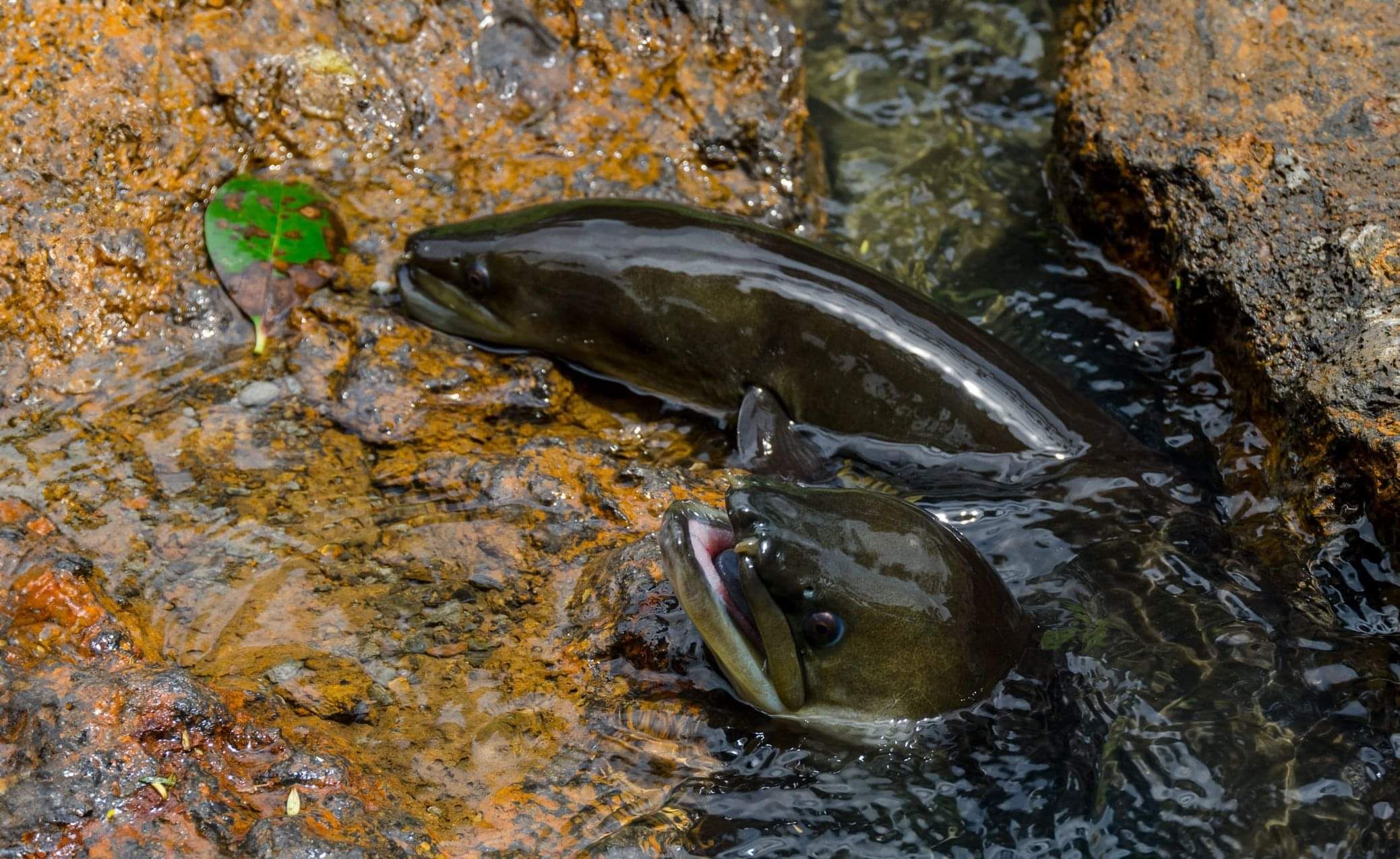Tuna / Longfin eel

Tuna/Longfin eel:
NZ's majestic migrators
Longfin eel can reach up to 2 metres in length!
Habitat: Rivers and inland lakes mainly but can live in all types of water.
Breeding season: April-June (only once in their lives).
Diet: Insect larvae, worms, water snails, fish, freshwater crayfish and small birds.
What’s their superpower?
After hanging out in freshwater streams and wetlands for decades, these wriggly rovers head out for what is quite literally their journey of a lifetime.
They glide upstream, scale waterfalls and slither over land before making the 2,500+ km journey at depths of up to 900m to a secret spot in a deep ocean trench in the South Pacific where they lay up to 20 million eggs then die.
Their tiny larvae drift back on ocean currents, arriving as clear glass eels that wriggle into estuaries and head upstream. After around 20-30 years of freshwater living, they turn silver and head back to sea — ending where they began.
Why do we need them?
As NZ’s only endemic freshwater eel, they’re vital to our ecosystem, both as predator and prey. They also feed on decaying animals which keep waterways clean. Plus, because they’re so huge, they need plenty of space which makes them super sensitive to habitat loss. If numbers drop, it’s a sign their habitat is in trouble.
Did you know?
They’re the world’s largest eels. Females can grow to the height of a doorway and weigh roughly as much as a 5-year-old.
Fascinating facts
Gone in one gulp: Large eels can eat their food live and whole, including fish and small birds. A 9-kg longfin eel was once reported to have eaten an entire duck.
Slippery seniors: Though their average lifespan is 35-52, longfin eels can live for 100+ years - the oldest documented in NZ was 106.
Champion climbers: Young eels are incredible climbers able to scale 20+ metre dams and waterfalls.
Serial transformers: They go through multiple full-body makeovers during their lives: from larvae to transparent (glass) eels to grey/brown elvers to silver-bellied adults.
Fuelled by fat: They don’t eat a single thing during their epic 6-month migration to sea. Instead, they survive on fat stored during freshwater years. Because of this, their stomachs shrink to save energy and make way for reproductive organs.

Conservation corner
Sadly, longfin eels are classed as At Risk – Declining by DOC. They don’t cope well with changes to their environment compared with their shorter-finned relatives and are threatened by pollution, dams, loss of vegetation and overfishing.
How you can help
● Avoid catching them. If you accidentally do, gently return them to the water.
● Fence off stream banks to keep livestock out and protect eel habitats.
● Plant native trees along stream edges to provide shade, improve water quality and offer food sources.
● Stop pollutants like chemicals, waste or sediment from entering waterways.
● Get involved in wetland restoration projects that aim to restore and protect longfin eels.
Help us to help the Tuna / Longfin eel
One of New Zealand's top predators, the longfin eel is endemic to New Zealand, likely the biggest eel in the world reaching up to 2 metres in length, and can live for as long as 80 years.
With over 75% of our indigenous species at risk of extinction*, the Pest Free Waitākere Ranges Alliance is raising funds to help defend the many special species of the Waitākere Ranges.
Thank you for your support of the longfin eel!
Laingholm / Tuna / Longfin eel
Supporter Gear
Support the conservation efforts of Pest Free Waitākere Ranges Alliance!
By shopping with us, you're contributing to the protection and preservation of our ngahere, and supporting our vision of a restored and thriving Waitākere Ranges.
Choose from a range of clothing and accessories printed with our exclusive design by local artist Romina Romera featuring Laingholm's special species – the Tuna / Longfin eel.
Find out more
Image credits: Matuku eels by Stefan Marks • Longfin eel by Doug Miller • Fern by Toby Hall on Unsplash.

